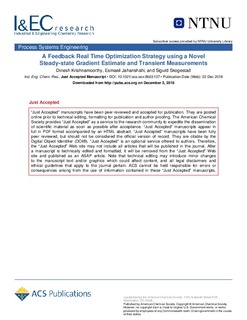| dc.contributor.author | Krishnamoorthy, Dinesh | |
| dc.contributor.author | Jahanshahi, Esmaeil | |
| dc.contributor.author | Skogestad, Sigurd | |
| dc.date.accessioned | 2019-03-28T12:19:44Z | |
| dc.date.available | 2019-03-28T12:19:44Z | |
| dc.date.created | 2019-01-09T23:36:48Z | |
| dc.date.issued | 2019 | |
| dc.identifier.citation | Industrial & Engineering Chemistry Research. 2019, 58 (1), 207-216. | nb_NO |
| dc.identifier.issn | 0888-5885 | |
| dc.identifier.uri | http://hdl.handle.net/11250/2592207 | |
| dc.description.abstract | This paper presents a new feedback real-time optimization (RTO) strategy for steady-state optimization that directly uses transient measurements. The proposed RTO scheme is based on controlling the estimated steady-state gradient of the cost function using feedback. The steady-state gradient is estimated using a novel method based on linearizing a nonlinear dynamic model around the current operating point. The gradient is controlled to zero using standard feedback controllers, for example, a PI-controller. In the case of disturbances, the proposed method is able to adjust quickly to the new optimal operation. The advantage of the proposed feedback RTO strategy compared to standard steady-state real-time optimization is that it reaches the optimum much faster and without the need to wait for steady-state to update the model. The advantage, compared to dynamic RTO and the closely related economic NMPC, is that the computational cost is considerably reduced and the tuning is simpler. Finally, it is significantly faster than classical extremum-seeking control and does not require the measurement of the cost function and additional process excitation. | nb_NO |
| dc.language.iso | eng | nb_NO |
| dc.publisher | American Chemical Society | nb_NO |
| dc.relation.uri | https://pubs.acs.org/doi/10.1021/acs.iecr.8b03137 | |
| dc.title | Feedback Real-Time Optimization Strategy Using a Novel Steady-state Gradient Estimate and Transient Measurements | nb_NO |
| dc.type | Journal article | nb_NO |
| dc.type | Peer reviewed | nb_NO |
| dc.description.version | acceptedVersion | nb_NO |
| dc.source.pagenumber | 207-216 | nb_NO |
| dc.source.volume | 58 | nb_NO |
| dc.source.journal | Industrial & Engineering Chemistry Research | nb_NO |
| dc.source.issue | 1 | nb_NO |
| dc.identifier.doi | 10.1021/acs.iecr.8b03137 | |
| dc.identifier.cristin | 1653666 | |
| dc.relation.project | Norges forskningsråd: 237893 | nb_NO |
| dc.description.localcode | © American Chemical Society 2018. This is the authors accepted and refereed manuscript to the article. Locked until 3.12.2019 due to copyright restrictions. | nb_NO |
| cristin.unitcode | 194,66,30,0 | |
| cristin.unitname | Institutt for kjemisk prosessteknologi | |
| cristin.ispublished | true | |
| cristin.fulltext | postprint | |
| cristin.qualitycode | 2 | |
